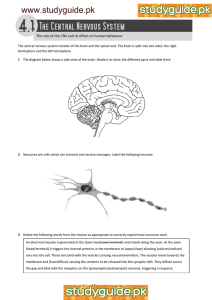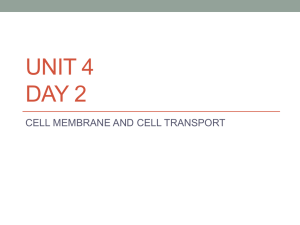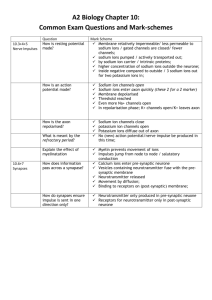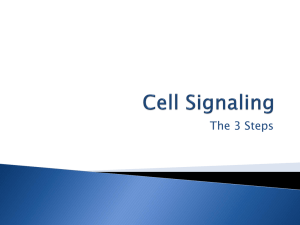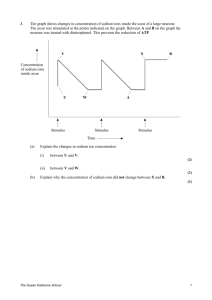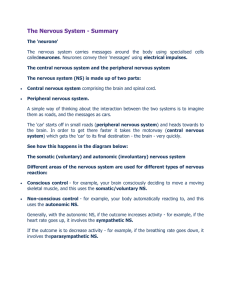Communication and Homeostasis
advertisement
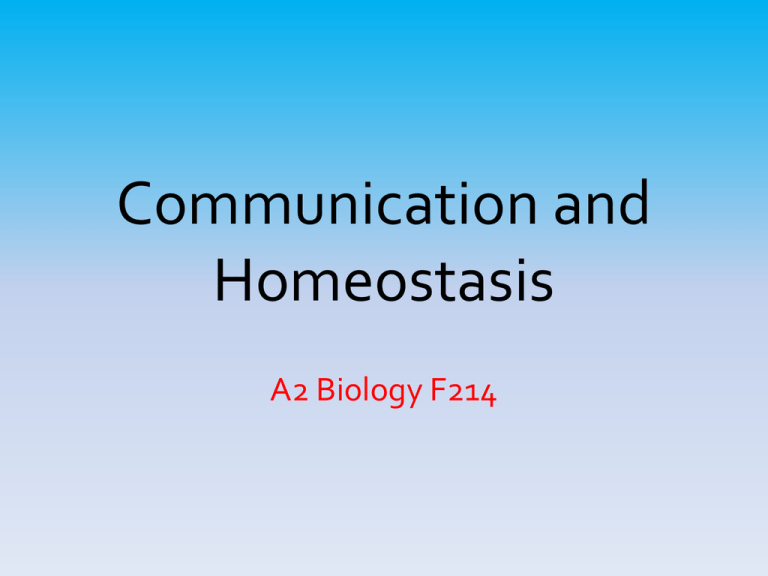
Communication and Homeostasis A2 Biology F214 Why do multi cellular organisms need communication systems? • Organisms need to detect changes in their external environment eg: pressure on skin, light, sounds, temperature, chemicals etc. The receptor cells need to signal these changes to the organism so it can respond and maintain its safety. Why do multi cellular organisms need communication systems? Organisms need to detect changes in internal environments such as temp, pH, water potential of blood , tissue fluid, level of toxins, etc as these can affect the ability of cells to function efficiently. Enzymes, dehydration, lack of respiratory substrate, toxins inhibiting metabolism, etc. Why do multi cellular organisms need communication systems? • Organs work together to maintain a constant internal environment with different organs having different functions. These functions have to be coordinated to keep the environment constant (Homeostasis) • Pancreas, liver, muscles, digestive system organs are all used to maintain blood glucose levels. Why do multi cellular organisms need communication systems? • Cell Signalling: one cell releases a chemical that is detected by another cell. The second cell may respond to the chemical signal in any of a large number of ways depending on the type of cell and the chemical stimulus recieved. • Cells signal using hormones (the Endocrine system) that travel in the blood stream and are picked up by their target cells. The endocrine system enables long-term responses. Why do multi cellular organisms need communication systems? • Nerve impulses are transmitted by neurone networks across synapses using neurotransmitters. This allows fast signalling and responses to rapidly changing stimuli. Homeostasis •What does it mean? Homeostasis • A system of monitoring and adjustment to keep conditions within safe limits Homeostasis Monitoring Controlling Internal conditions To keep them constant (or within safe limits) Despite external changes Egs • temperature • blood glucose levels • blood salt concentration • relative water potential of blood, tissue fluid and cells, • pH • Blood pressure • CO2 levels Negative Feedback Can you complete this with some real life examples? Positive Feedback Can you complete this with some real life examples? Maintaining Body Temperature • Describe the physiological and behavioural responses that maintain a constant core body temperature in ECTOTHERMS. (What is an ECTOTHERM?) • Describe the physiological and behavioural responses that maintain a constant core body temperature in ENDOTHERMS, with reference to peripheral temperature receptors, hypothalamus and effectors in skin and muscles. (What is an ENDOTHERM?) Maintaining temperature in ECTOTHERMS Think of some ways these animals may be able to regulate their body temperature Control of temperature • Ectotherms • Seek sun or shade depending on outside temperature • Expose more or less body surface to sun • Alter body shape to change surface area • Increase breathing movements to evaporate more water Maintaining temperature in ENDOTHERMS Think of some ways these animals may be able to regulate their body temperature Control of temperature • • • • • • • • • • Endotherms Sweating Panting Piloerection Vasodilation /vasoconstriction Metabolic rate in liver Shivering Seek sun or shade Alter orientation of body Alter activity level Diagram to show changes to skin surface blood vessels in warm and cold conditions. Sensory Receptors and Nerve Impulses Learning Outcome 1 • Outline the roles of sensory receptors in mammals in converting different forms of energy into nerve impulses What is a transducer? • A cell that transforms one type of energy into another • Each type of transducer detects changes in a particular form of energy (the stimulus) • Although receptors detect changes in different stimuli the receptor always converts this change to electrical energy known as a nerve impulse Sense organs, receptors and stimuli Sense Organ Eye Nose Tongue Skin Ear Muscle Type of receptor What does it detect? Sense organs, Sensory Receptors and Stimuli Eye Rods and cones (light sensitive cells) Light intensity (rods) and wavelength (cones) Nose Olfactory cells lining inner surface of nasal cavity Presence of volatile chemicals Taste buds in tongue, hard palate, epiglottis and first part of oesophagus Presence of soluble chemicals Pressure on skin Skin Pacinian corpuscles (pressure receptors) Ear Sound receptors in cochlea (inner ear) Vibrations in air Proprioceptors (stretch detectors) Length of muscle fibres Tongue Muscle Learning outcome 2 • Describe with the aid of diagrams the structure & functions of sensory & motor neurones Structure of neurones Sensory and Motor neurones Node of Ranvier Axon terminal Myelin sheath Made of Schwann cells Axon terminal The Myelin Sheath Diagram of the process of myelination of an axon. Myelination begins with the invaginations of a single nerve axon into a Schwann cell; a mesoaxon is then formed. As myelination proceeds, the mesoaxon rotates around the axon enveloping it in concentric layers of Schwann cell cytoplasm and plasma membrane which contain high levels of electrically insulating lipid Electron micrograph of myelinated neurone (cross section) • l neurone Layers of Schwann Cell cytoplasm and membrane Learning outcome 3 • Describe and explain how resting potential is established and maintained Establishing the “Resting Potential” • At rest, the inside of a neuron's membrane has a negative charge (resting potential). • As the figure shows, a Na+ / K+ pump in the cell membrane pumps 3 sodium ions out of the cell and 2 potassium ions into it using ATP. (Type of transport?) • However, because the cell membrane is a bit leakier to potassium than it is to sodium, more potassium ions leak out of the cell. (Type of transport?) • There are also many organic anions (-ve charged) in the cytoplasm • As a result, the inside of the membrane builds up a net negative charge relative to the outside. (-70mV is the resting potential, the cell is “polarised” Sodium – Potassium pump online tutorial http://highered.mcgrawhill.com/sites/0072 495855/student_view0/chapter3/animatio n__sodiumpotassium_exchange_pump__quiz_1 • Describe and explain how an action potential is generated • In all receptors changes in the level of the stimulus (changes in energy levels) result in changes in permeability of the membrane to Na and K ions 35 Small stimuli don’t cause a big enough change in p.d. to generate an action potential. (P.d. doesn’t reach generator potential.) Generating an Action Potential • Stimulation of the receptor causes Na+ channels to open. The bigger the stimulus the more channels open. • Na+ ions diffuse into cell lowering potential difference • This makes even more channels open (positive feedback) • When potential difference reaches threshold (-50mV) the voltage gated Na+ channels open Generating an Action Potential (2) • As more Na ions flood in the potential difference across the membrane changes to +40mV • Voltage gated K channels open and Na channels close (2&3) • K ions diffuse out of cell repolarising the cell (4) • So many ions diffuse out that the cell is hyperpolarised (5) • The Na/K pump reestablishes the resting potential (6) Local Current Transmission of Action Potentials in myelinated neurones (Saltatory conduction) 3 • • • • • AP at 1 causes Na ions to move into axon Na ions diffuse to areas of –ve charge further down axon towards 2 Voltage gated Na channels are only present at Nodes of Ranvier So new AP starts at 3 and so on The impulse moves in one direction only as it takes time to re-establish distribution of ions using the Na/K pump. • So the neurone cannot depolarise again immediately in that region (refractory period) Transmission of Action Potentials in myelinated neurones (Saltatory conduction) Describe, with the aid of diagrams, the structure of a cholinergic synapse. The Synaptic Knob of Pre-synaptic Neurone Post synaptic membrane The postsynaptic membrane with a sodium ion channel and sodium ion channel opened by acetylcholine Outline the role of neurotransmitters in the transmission of action potentials. • Outline the roles of synapses in the nervous system. These EPSPs do not reach the threshold potential But when several are added together sufficient Na ions have entered the cell to initiate a new action potential Extension: Animation showing the linking of an action potential to muscle movement http://www.youtube.com/watch?v=70DyJ wwFnkU&feature=PlayList&p=80C4BB587 45CB30E&index=17 Animation to explain a synapse http://www.youtube.com/watch?v=HXx 9qlJetSU&feature=PlayList&p=80C4BB5 8745CB30E&index=29 Use your new knowledge to create a script to describe and explain the following animation: http://www.youtube.com/watch?v=90cj4 NX87Yk&feature=PlayList&p=80C4BB58 745CB30E&index=24 Compare and contrast the structure and function of myelinated and non-myelinated neurones. • Outline the significance of the frequency of impulse transmission.
